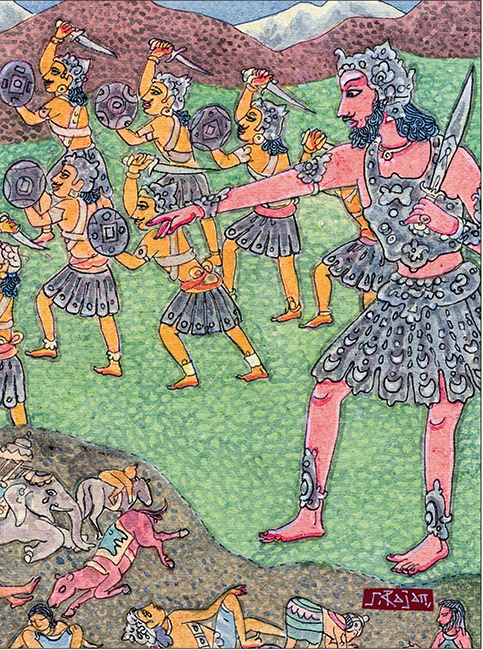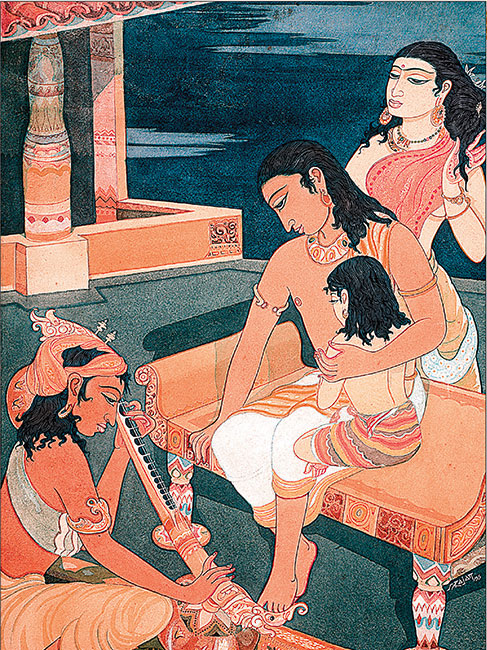PUBLISHER’S DESK • OCTOBER 2016§
Making Dharma Your Own
______________________§
Understanding and applying to your daily life five dimensions of Hinduism’s complex principle of virtue, duty, ambition and livelihood§
______________________§
BY SATGURU BODHINATHA VEYLANSWAMI§
 DHARMA IS A COMPLEX AND COMPREHENSIVE term with many meanings, including religion, divine law, law of being, way of righteousness, ethics, duty, responsibility, virtue, justice, goodness and truth. In its most general sense dharma is that which sustains the orderly fulfillment of an inherent nature or destiny. It comes from the Sanskrit root dhṛ, “to sustain; carry, hold.” Thus we can say that dharma is that which sustains the cosmos, human society and each member of society. Relating to the individual soul, it is the mode of conduct most conducive to spiritual advancement, the right and righteous path. As the meaning of dharma is so broad, I find it best not to translate it into English but rather use the word dharma itself, which works since the term, like so many Sanskrit words, is gradually being absorbed into the English language.§
DHARMA IS A COMPLEX AND COMPREHENSIVE term with many meanings, including religion, divine law, law of being, way of righteousness, ethics, duty, responsibility, virtue, justice, goodness and truth. In its most general sense dharma is that which sustains the orderly fulfillment of an inherent nature or destiny. It comes from the Sanskrit root dhṛ, “to sustain; carry, hold.” Thus we can say that dharma is that which sustains the cosmos, human society and each member of society. Relating to the individual soul, it is the mode of conduct most conducive to spiritual advancement, the right and righteous path. As the meaning of dharma is so broad, I find it best not to translate it into English but rather use the word dharma itself, which works since the term, like so many Sanskrit words, is gradually being absorbed into the English language.§
A book traditionally studied at a young age in Tamil schools is Saint Auvaiyar’s ancient work Atti Chudi. It consists of 109 one-line verses that, while teaching the alphabet, provide guidelines on right living. The first verse is on dharma. It says: “Aram (dharma) seya virumbu,” or “Desire to fulfill dharma.” This shows the long-standing importance of dharma in Hindu education. And it sounds so simple! However, dharma has so many subtleties that many youth find it challenging to relate to the concept. In response, we explore here five aspects of the term and their application in life.§
1. Right Living Begins with Ganesha: The first and core meaning of dharma is living virtuously and fulfilling duty. It includes all the noble behaviors that we know are right and good. One learns to be selfless by thinking of others first, being respectful of parents, elders and swamis, following divine law, especially ahimsa, which is mental, emotional and physical noninjury to all beings. My guru, Sivaya Subramuniyaswami, taught that the worship of Lord Ganesha puts one naturally on the path of virtuous living. “Ganesha sits on the psychic lotus of the muladhara chakra, the ganglia of nerves at the base of the spine within everyone. This chakra governs time, matter and memory. As the spiritual aspirant is lifted up from fear and confusion into conscious awareness of right thought, right speech and right action, the muladhara chakra becomes activated….But the seeker loses one thing. He loses his free, instinctive willfulness. It is lost forever. Yet it is not a great loss. Man’s own personal willfulness, his animalistic free will, is a feeble and insignificant force when compared to Lord Ganesha’s divine will. When beholden to God Ganesha and inwardly awakened enough to be attuned to His will, it is then quite natural that the instinctive will bows down. Personal likes and dislikes vanish. Limited faculties of reason and analysis are overpowered and subdued by a greater will, a cosmic will, the will of dharma.”§
2. Two Paths, Two Dharmas: Recently I gave a presentation at a weekend retreat of the Hindu Students’ Association. One of many written questions submitted to me in advance showed a common misunderstanding. “We talk about detachment from maya, but for most of us our career and living is centered around worldly subjects and concerns. How can we reconcile this fact with our larger desire to separate from the material world?” In their pursuit of dharma, these youth were struggling with the Upanishadic concept of self-abnegation, thinking that it applies to all Hindus, thinking they should be more detached from worldliness. I pointed out that it is vital to understand that in Hinduism there are two distinct paths: that of the householder, called grihastha dharma, and that of the renunciate, sannyasa dharma. Self-abnegation and detachment from maya belong to the renunciate path, not the householder path. This distinction of two paths is our second aspect of dharma.§
To quickly cognize the differences between the two, take a look at the ancient ethical masterpiece Tirukural by Tiruvalluvar. In Part One, entitled “Virtue” or “Dharma” (aram), Section Two is “The Way of the Householder,” and Section Three is “The Way of the Renunciate.” Scanning the chapter titles immediately reveals the deep distinctions. Chapters in the householder section include: Wife, Children, Love, Hospitality, Gratitude, Possession of Self-Control and Avoidance of Covetousness. The final three chapters focus on giving to others so generously as to achieve renown in the community. Chapters in the renunciate life section include Austerity, The Impermanence of All Things, Renunciation, Knowledge of Truth and Eradication of Desire. Without even reading the actual verses, it is clear that detaching from the materialistic world is a goal for those on the renunciate path but not those on the householder path.§
For Hindu monks, the Tirukural stresses renunciation of wealth. For the householder, becoming wealthy is encouraged—with the goal of generously sharing one’s abundance with others. A contemporary example of the latter is a person Hindu youth and young adults readily relate to—Mark Zuckerberg, cofounder and CEO of Facebook. Mark celebrated the birth of his daughter in December 2015 by pledging to give away 99 percent of his Facebook shares. Money from the shares, currently valued at US$45 billion, will go to projects and charities that advance human potential and promote equality.§
3. Which Stage of Life? Our third aspect of dharma is ashrama dharma—the natural expression and maturing of the body, mind and emotions through four progressive stages. This idea was developed millennia ago and detailed in scriptures known as Dharma Shastras to highlight the fact that our dharma, or duty, changes and evolves as we mature from youth to adulthood, senior years and old age. My guru considered that in modern times each ashrama is a 24-year period, applying equally to men and women, as follows:§
 BRAHMACHARYA: student, birth to age 24, learning, pursuing secular and religious studies§
BRAHMACHARYA: student, birth to age 24, learning, pursuing secular and religious studies§
 GRIHASTHA: householder, age 24 to 48, raising a family, fulfilling a career or profession, serving the community§
GRIHASTHA: householder, age 24 to 48, raising a family, fulfilling a career or profession, serving the community§
 VANAPRASTHA: elder advisor, age 48 to 72, offering one’s experience to help others§
VANAPRASTHA: elder advisor, age 48 to 72, offering one’s experience to help others§
 SANNYASA: retiree, age 72 onward, withdrawing from society and devoting more time to religious practices§
SANNYASA: retiree, age 72 onward, withdrawing from society and devoting more time to religious practices§
4. Four Positive Goals: Our fourth key to dharma is to understand it as one of the four goals of life. The Sanskrit term is purushartha, which literally means “human wealth.” These are four pursuits in which people may legitimately engage. Also called chaturvarga, “fourfold good,” they form a cornerstone of Hindu ethics: 1) dharma, or duty and piety; 2) artha, wealth; 3) kama, love and enjoyment; and 4) moksha, enlightenment and liberation from rebirth. It is vital to note that while dharma is a goal in its own right, it is also the guiding principle of the other three goals, as it defines the proper way to pursue wealth, pleasure and moksha. Do we acquire wealth in a virtuous and honest way? Are spouses faithful to one another? Dharma—virtue and piety—is the steady guide for artha and kama, ultimately leading the soul to moksha.§
5. Your Occupation: A fifth aspect of dharma relates to one’s profession. In Sanskrit it is called varna dharma. As we read in Dancing with Siva: “Varna dharma defines the individual’s obligations and responsibilities within the nation, society, community, class, occupational subgroup and family.” In some professions the principles, or dharma, that guide it are defined in formal declarations. For example, Western medical doctors take the Hippocratic Oath, which includes this promise: “I will apply, for the benefit of the sick, all measures which are required, avoiding those twin traps of over-treatment and therapeutic nihilism.” Lawyers take an oath, one version of which states, “I will employ, for the purpose of maintaining the causes confided to me, such means only as are consistent with truth and honor…” Other professions, such as certified public accountants, have a written code that members are expected to follow. The hundreds of occupations without formal oaths or codes have traditional expectations which constitute an informal understanding of their dharmic ideas. The idea is that when individuals fulfill their respective varna dharma, the whole of society functions smoothly. Pondering this fifth dimension of dharma keeps us reminded of the ethics, goals and guidelines of our occupation.§
By meditating on and understanding these five aspects of dharma, youth and adults can unfold a much better sense of dharma’s place in their life and thus strive in an informed way to fulfill the first verse of Atti Chudi: “Desire to fulfill dharma.”§

How dharma flows: (top to bottom) A mother applies a tilaka to her daughter’s forehead as a sign of purity; family men seek guidance from a swami; this family exemplify three of life’s stages; a youth has discovered happiness in the pursuit of life’s dharmic goals; two paramedics apply their professional training in a moment of emergency.§
PUBLISHER’S DESK • OCTOBER 2013§
Temple as the Source of Culture
______________________§
By consciously connecting the home shrine to the temple, the family sustains tradition and strengthens relationships§
______________________§
BY SATGURU BODHINATHA VEYLANSWAMI§
 FOR SOME TWENTY-FIVE YEARS, FROM about 1975 to 2001, HINDUISM TODAY’S founder, Satguru Sivaya Subramuniyaswami, was instrumental in helping temples get established. Gurudeva guided 37 temples in the United States, Canada, Guadeloupe, Denmark, England, Fiji, Germany, Mauritius, New Zealand, Reunion, Russia, Sweden and Sri Lanka—giving each community or temple an icon of God, usually Lord Ganesha, and guidance when needed. He also helped dozens more temples by sharing his global experience and understanding of community building or by publicizing their project in HINDUISM TODAY.§
FOR SOME TWENTY-FIVE YEARS, FROM about 1975 to 2001, HINDUISM TODAY’S founder, Satguru Sivaya Subramuniyaswami, was instrumental in helping temples get established. Gurudeva guided 37 temples in the United States, Canada, Guadeloupe, Denmark, England, Fiji, Germany, Mauritius, New Zealand, Reunion, Russia, Sweden and Sri Lanka—giving each community or temple an icon of God, usually Lord Ganesha, and guidance when needed. He also helped dozens more temples by sharing his global experience and understanding of community building or by publicizing their project in HINDUISM TODAY.§
Why did Gurudeva devote so much energy to helping establish the temples of organizations with no formal ties to his own? He did it because of a strong conviction that it is the temple that perpetuates Hindu culture. As he explained, if Hindus move to a country and do not build a temple, after a few generations their precious culture will have been lost.§
At a satsang held in July 2000, a devotee asked Gurudeva: “What’s happening to Hindu culture? It seems in Bollywood, actors and actresses are turning Western and encouraging everyone else to do so. Will Hindu culture, or Indian culture, last very long after this?”§
Gurudeva responded: “We can see in the world today that combative culture—where people do not get along but sometimes pretend to get along when they do not get along—comes from the offices and the factories and the nonreligious activities. Indian culture may be going down in India, but it is definitely coming up in the West because of the worship within the temples. It’s our relationship with God, the Gods and the Goddesses that establishes our relationship with men, women and children. Culture comes from being sensitive to other people’s feelings as we are sensitive within the temple to the feelings of the Gods and the vibration emanating from the inner sanctum. Without religion in one’s life and the practice of that religion in the home shrine, in the temple, and pilgrimage once a year to a far-off place, culture quickly fails and the competitive culture comes into play.”§
He continued, “While there are many that are trying to bring the best of the West to the Far East, there are still in the West many who are trying to bring the best of the Far East into the West. As long as religion and worship and the practice of pilgrimage and all the refinements of our great religion are present, culture will be there.”§
The Hindu temple can act as a powerful spiritual hub that radiates out Hindu culture and devotional practices into the homes of families who attend regularly, at least once a week. The process of strengthening culture can happen on a number of levels.§
The most basic is simply learning and following the many traditions and protocols associated with visiting a temple. No devout Hindu will approach the sacred home of God without proper preparation. The simple necessities include a bath, donning clean clothes and preparing an offering tray, whether simple on a normal day or elaborate for a festival. These acts are all important parts of temple-going.§
On arrival we need to wash our feet and handle shoes in the specified way. Then the customary prostrations to the Deities, followed by circumambulation and presenting our offerings with a loving heart. When attending puja, men and women may be required to sit on separate sides of the mandapam. At key points throughout the rites we pray and respond in specific ways. As children follow the parents’ traditional protocols, they develop an appreciation for worship and sacred objects, respect for elders, an understanding of the importance of physical cleanliness and mental purity, and a fondness for familial and communal devotion.§
After years of such practice, essential character qualities, such as humility and devotion, can deepen. Devotion here means love of God. These qualities, which are present in every cultured Hindu, may not develop in an individual growing up in the West unless he or she participates in regular worship.§
The second level of the temple’s influence on the home begins when a shrine is established in the home and worshiped at daily. Wherever possible, it should be a separate room, not in a cabinet or on a shelf. Such a dedicated space makes everyone living in the home think more about God, reflect more on their behavior and be less inclined to become angry or argue, as they are living in God’s presence.§
Going to the temple every week can actually bring some of the temple’s sanctity into the shrine room. My guru taught that lighting an oil lamp in the shine room after coming home from the temple brings the temple’s shakti into your home. That devotional act brings devas who were at the temple into the home shrine, where, from the inner world, they can bless the family and protect the home.§
The temple’s third level of cultural influence begins when a family member, generally the father, performs regular puja in the home. In a sense, he becomes the family priest, emulating the temple priests while following a simpler, non-public liturgy known as atmartha puja. Such a full puja done daily steadily strengthens the home’s religious vibration.§
Quite fittingly, the structure of the puja ceremony arises from the magnanimous spirit of hospitality for which Hindu culture is famous. All guests are received and treated as God, and God is no exception. During this daily morning puja rite, family members gather in their well-appointed shrine room to honor God as their royal guest. They receive Him warmly, offer a seat, serve water to quench His thirst, bathe and dress Him in beautiful clothes, burn the finest incense for His enjoyment, honor Him with light, flowers, chanting and offerings of food. It is an intimate, personal interaction. Throughout the puja, the officiant chants sweetly to the Deity in Sanskrit, describing these kindly acts and beseeching His blessings. Finally the pujari thanks the Deity for His presence, bids Him farewell and humbly apologizes for any errors he may have unknowingly committed.§
The fourth level of temple influence on the home begins when the shrine is strong enough that we feel that the main Deity of the shrine, for example Lord Siva or Lord Venkateshvara, is the head of the house. When that happens, we would never think of having a meal without first offering a portion to God. We would naturally want to always worship God, even if briefly, before leaving the home and upon returning.§
For Hindu culture to strengthen the home to this extent, the entire family needs to be involved. To illustrate, let me share a story. One of our devotees was responsible for the Sunday morning Hinduism classes for a group in Singapore. He found that parents would commonly drop the children off, go shopping for two hours, return and pick them up, all the while expecting the teachers to make their children better Hindus. Though this approach works for learning the fine arts, such as dancing or playing an instrument, it does not work for Hinduism.§
The difference is this. For children to learn dance or music, the parents need not know how to dance or play the instrument. However, for Hinduism to be learned, it is necessary for the whole family to practice it together. This is because Hinduism is an all-encompassing spiritual way of life, informing every aspect of the family’s daily and weekly routine, and not just in the shrine room. Having the children study Hinduism at the temple is important. But if the parents are also involved in the study, there is much greater potential for actually augmenting Hindu culture and religious conversations in the home. In fact, some Hindu groups will not accept children into classes unless the parents also enroll in a parallel study for adults.§
I like to compare Hindu temples to an electrical distribution system. On the remote Hawaiian island of Kauai, where we live, there is one main electrical generating plant with power lines to five distribution substations to which customers in each region are connected. This can be likened to a ray of spiritual energy coming from the celestial worlds (electrical plant) to five temples (substations), each with a connection which powers the homes of devotees who worship there regularly (customers). The electricity lights up the house and empowers all sorts of appliances. The energy from the temple illumines the family’s path and enlivens the culture.§
PUBLISHER’S DESK • OCTOBER 2004§
What Is True Success?
______________________§
Hinduism favors and furthers the pursuit of wealth, pleasure and happiness—all guided by dharma§
______________________§
BY SATGURU BODHINATHA VEYLANSWAMI§
 IN TODAY’S MATERIAL WORLD, SUCCESS IN LIFE is popularly measured by looking solely at people’s professional and family life. Do they have a good, well-paying job and a large home with a highly educated spouse and intelligent children? If the answer is yes, then they are considered to be successful. We will take that as our initial definition of success and throughout this article deepen and broaden it in important ways.§
IN TODAY’S MATERIAL WORLD, SUCCESS IN LIFE is popularly measured by looking solely at people’s professional and family life. Do they have a good, well-paying job and a large home with a highly educated spouse and intelligent children? If the answer is yes, then they are considered to be successful. We will take that as our initial definition of success and throughout this article deepen and broaden it in important ways.§
Parents are naturally focused on making sure their children are as successful in life as possible, which is good. However, unfortunately, some Hindu parents feel that their children’s participation in Hindu religious activities and studies is a complete waste of time, meaning that it contributes nothing at all to their becoming successful. This attitude is based on incorrect concepts, such as the following: 1) Hinduism encourages us to look at the world as unreal and thus take no interest in material success; 2) Hinduism values world-renunciation and thus stands against the acquiring of wealth and the enjoyment of life; 3) Hinduism’s devotional practices and attending the Hindu temple are only for field and factory workers and not for educated professionals. These three concepts are, of course, incorrect, because Hinduism, when properly taught and practiced, helps us be more successful in all dimensions of life.§
Four Legitimate Goals: Let’s begin deepening our understanding of the Hindu view of success by looking at the concept of the purusharthas, a term which literally means “human wealths or goals.” These are four pursuits in which humans may legitimately engage. Also called chaturvarga, “fourfold good,” they form a cornerstone of Hindu ethics. They are piety, wealth, pleasure and liberation. The achievement of the second and third of these goals, wealth and pleasure, is clearly identical to our initial definition of success, and thus we can see that Hinduism—contrary to what many people believe—is vitally concerned with an individual’s being successful in worldly life. Said another way, wealth and pleasure—artha and kama—are natural goals of all humans, including Hindus.§
Artha is material welfare and abundance, money, property, possessions. It includes the necessities of life—food, money, clothing and shelter—and extends to the wealth required to maintain a comfortable home, raise a family, fulfill a career and perform religious duties. My Gurudeva adds a broader meaning to artha when he describes it as embracing financial independence, freedom from debt, worthy children, good friends, leisure time, faithful servants, trustworthy employees, the joys of giving, feeding the poor, supporting religious mendicants, worshiping devoutly, protecting all creatures, and offering hospitality to guests. In other words, artha measures not only riches but also the quality of life, providing the security needed to pursue kama, dharma and moksha.§
Kama is earthly love, aesthetic and cultural fulfillment, pleasures of the world (including sexual), joys of family and friends, intellectual satisfaction, happiness, security, physicality, creativity, usefulness and inspiration.§
Moksha, or mukti, is freedom from samsara, the rounds of birth and death. It occurs after karma has been resolved and realization of the Self God has been attained. The desire for moksha only comes after a soul has pursued and been successful in fulfilling dharma, artha and kama for numerous lives, so that it is no longer attached to worldly joys or sorrows. Said another way, those who renounce the world in this life in one-pointed pursuit of moksha do so having achieved worldly success and fulfillment in past lives. §
While dharma is a goal in its own right, it is also the guiding principle of the other three, as it defines the proper way to pursue wealth, pleasure and moksha. Do we acquire wealth in a virtuous and honest way? Are spouses faithful to one another, or not? These are concerns of all the world’s religions, including Hinduism. Dharma, piety, now enters the picture. Dharma is the fulfillment of virtue, good works, duties and responsibilities, restraints and observances, performing one’s part in the service and upliftment of society. It includes religious disciplines and the pursuit of truth under a guru of a particular lineage (parampara) and tradition (sampradaya). It is the steady guide for artha and kama, and ultimately it leads the soul to moksha.§
Building Good Character: Parents, of course, want their children to bring honor to the family name, to be pillars of their community and to be of unblemished character. They know that without good character true success is not possible. Good conduct and good character are not taught in most secular schools. Therefore, the natural place to learn them is in a children’s class on Hinduism. Academic studies teach us how to read and write. But religious studies teach us what to read and write, which is equally important. Good conduct is the foundation of all other practices in Hinduism.§
Happiness: From the Hindu point of view, happiness is the natural outcome of the fulfillment of the purusharthas. Many adults have told me that they are surprised that even though they have, after many years, achieved the professional and family goals they thought would make them happy, they find they are not happy. This can be discouraging, disillusioning and depressing, even leading some to commit suicide. In looking back, many realize they neglected their religious life, dharma, at the expense of seeking wealth and worldly enjoyments. They see now that they are not content, not fulfilled, because they failed to devote equal energy to spiritual practice, attending the temple, meditation, hearing the words of enlightened teachers and studying the scriptures.§
Many resolve at this point to teach their children what they learned the hard way, that dharma is the center pole of success, and happiness is its flag of victory. Dharma includes holding firm to a religious view of life and the universe—embracing the wisdom of Sanatana Dharma on all levels of our being—a view which my guru said is simply the best description of the way things actually are. This means seeing the world as the arena of our evolution as divine beings on a spiritual journey extending many lifetimes, knowing that we come from God, live in God and ultimately will merge in God. Abiding by this spiritual, mountaintop perspective, facing each challenge as our own self-created karma, gives us the inner stability, poise and contentment that we call enduring happiness, known in Sanskrit as ananda, the natural bliss of the soul. It enables us to achieve success after success in all areas of effort, and it strengthens us to withstand the ups and downs, joys and sorrows, gains and losses that are natural to life on Earth. Striving for and achieving one’s goals exercises the nerve system not only of the physical body, but of the inner bodies as well, strengthening the soul body and furthering its evolution. That prowess can then be applied to all future endeavors, including spiritual pursuits. It can be carried from life to life. Through this process we learn that while real fulfillment is not to be found in the outer world, the world trains us how to find the peace and happiness we already have within ourselves.§
Hindu parents in temple societies across the US and Canada are realizing the importance of teaching these values to their youth, and they are seeking out programs and systems to do so. They are realizing that academic studies and Hindu practices we pursue in our youth have the effect of refining our desires to the point where we can, as adults, be religious enough to experience enduring happiness through connecting with our inner, spiritual self in three traditional ways: meditation, devotion and service. Through meditation, we go deep into the lotus of the heart and experience our inner self, our inner light, our spiritual energy. Through worship in the temple, we open ourselves to the blessings of the Deities. We can come to the temple in an unhappy state, receive the blessings of God and the Gods and go away uplifted and happy. Why? Because the blessings have cleared our mind and aura of congested thought forms and emotions, allowing us to connect with the same blissful state that can be achieved through meditation. And through helping and serving others, trying to make them happy, we naturally forget about ourselves and our problems. When we see the smile on the faces of those we are helping, it brings a smile to our face, opening access to our inner happiness.§
In summary, the popular, materialistic view of success focuses narrowly on wealth and pleasure. To achieve lasting happiness, the hallmark of real success, the devout Hindu broadens the scope of success by pursuing dharma with the same vigor and enthusiasm. Hindus who fulfill this complete and high-minded paradigm will naturally be looked up to not only by their family, but by their community and nation, as embodying what it truly means to be a successful person. Hindus should be proud that their religion provides the tools they need to be truly successful in life. So, let us banish the three illusions that discourage parents from imparting the knowledge and use of those tools to their children. Let’s fulfill our duty to the next generation, knowing that: 1) our faith furthers personal success in the highest sense; 2) that it is fully supportive of acquiring wealth and enjoying life; and 3) that meditation, temple worship and helping others are sophisticated, success-building tools appropriate for Hindus of all walks of life. Knowing that it will contribute pragmatically to their success in life, let’s confidently teach Hinduism to the youth!§
PUBLISHER’S DESK • JULY 2011§
Be a Spiritual Leader!
______________________§
Uplift the spirit of everyone you meet by expressing kindness, gratitude, appreciation and encouragement§
______________________§
BY SATGURU BODHINATHA VEYLANSWAMI§
 FROM AUGUST 28 THROUGH 31 OF THE YEAR 2000, two thousand of the world’s preeminent religious and spiritual leaders, representing the many faith traditions, gathered at the United Nations in New York City for a “Millennium World Peace Summit of Religious and Spiritual Leaders” to pledge themselves to work for peace. Satguru Sivaya Subramuniyaswami, founder of HINDUISM TODAY, was among the Hindu delegates. Speaking at one gathering, he delivered the message: “For World Peace, Stop the War in the Home.” The talk was also published as his Publisher’s Desk column in the November/December 2000 issue:§
FROM AUGUST 28 THROUGH 31 OF THE YEAR 2000, two thousand of the world’s preeminent religious and spiritual leaders, representing the many faith traditions, gathered at the United Nations in New York City for a “Millennium World Peace Summit of Religious and Spiritual Leaders” to pledge themselves to work for peace. Satguru Sivaya Subramuniyaswami, founder of HINDUISM TODAY, was among the Hindu delegates. Speaking at one gathering, he delivered the message: “For World Peace, Stop the War in the Home.” The talk was also published as his Publisher’s Desk column in the November/December 2000 issue:§
“When asked by the United Nations leaders how humanity might better resolve the conflicts, hostilities and violent happenings that plague every nation, I answered that we must work at the source and cause, not with the symptoms. That is what we do in ayurvedic medicine, focus on the causes, on establishing the body’s natural balance and health. That way, we are not always working with illness and disease, we are spending time and resources instead to establish a healthy system that itself fights off sickness. To stop the wars in the world, our best long-term solution is to stop the war in the home. It is here that hatred begins, that animosities with those who are different from us are nurtured, that battered children learn to solve their problems with violence.”§
The summit caused me to reflect on the difference between a religious leader and a spiritual leader. The conclusion I came to is that a religious leader is a leader of a recognized religion. A spiritual leader is someone who is expert in uplifting the spirit of others. Some religious leaders are also spiritual leaders, and some are not. Some spiritual leaders are also religious leaders, and some are not. My Gurudeva was definitely both. In fact, he was an expert in uplifting the spirit of others no matter what their religion or ethnicity. How did he accomplish this? By speaking encouraging words. You, too, can be a spiritual leader. Simply make it a point to say something encouraging, complimentary and high-minded to everyone you meet. Their day will be brighter because of it, and so will yours. Your words may be just what they needed to escape a moody morning and discover a new energy for the day. Isn’t that what spiritual leaders do, change the energy, elevate the spirit so people connect with their intuition and open themselves to the highest course of action for the day?§
When encountering people you know, you can ask about some aspects of their life, such as their children or recent travel, and show an interest in their well-being. Gurudeva was skilled at this form of empathy. As a result, he was an important source of upliftment and encouragement for many people on Kauai from all walks of life.§
Meetings are excellent opportunities for encouraging others. Listen attentively to each individual’s ideas, and when they are good ideas be sure to compliment them. If someone is a bit shy in presenting an idea, make a few encouraging remarks to help him or her feel more confident. Control yourself by not dominating every meeting with your ideas and presence.§
Another way to be a spiritual leader is to uplift others by expressing gratitude for their help, friendship and presence in your life. Those who are full of gratitude lack nothing. They are filled with divine energy, complete, with nothing to require for their further happiness, nothing to regret. Their spirit is whole, their life is rich beyond measure. So, naturally, they are the spiritual leaders to others who feel less than perfect in their lives. Gratitude may seem an ordinary thing, but it is the touchstone of spiritual maturity. Showering your gratitude on others teaches them of their own fullness. One of the first ways to do so is to greet everyone with a good morning, afternoon or evening, and a smile. Keeping your mood elevated lifts everyone around you. Being kindly reminds them to show others kindness. Be the opposite of a complainer.§
Unfortunately, it is an all-too-common way of our times that when something is done that is good, helpful or loving, it is overlooked, treated as something expected. No acknowledgment is shown, no appreciation is expressed. But if a shortcoming is seen, everyone is swift to point it out, and often in an unkind manner! §
Let’s look at some common examples of not being grateful or expressing appreciation. 1) The mother of two teenage boys works hard every day to take care of her sons’ needs at home and at school. They take her efforts totally for granted and never say, “Thanks, Mom.” 2) A wife is faithfully attentive to her husband’s needs and supportive of his career. The husband never bothers to acknowledge her constant care. 3) A husband works hard to financially support his family, even toiling weekends to earn extra income. The wife, thinking it his duty, never expresses any gratitude for his tireless efforts. 4) A supervisor takes extra time with his staff to help improve their skills and advance their position. But not one of them ever expresses thanks for his leadership.§
Gurudeva developed two sadhanas in this area, one for gratitude and one for appreciation. He advised fulfilling the sadhana of gratitude first, then the sadhana of appreciation. The sadhana of gratitude is to take out paper and pen and list all the good that has come into your life during the past five years. As memory is stimulated, the list will grow. Gurudeva suggests that if you find yourself not able to even recall one good thing, write several times, “I am a spiritual being of light maturing in the ocean of experience.” This will stimulate a positive memory, which will soon be followed by more. Feelings of loving appreciation will begin to flow toward those who helped you in the good times. Feelings of acceptance and forgiveness will also well up for the bad times. This sadhana echoes the wisdom found in the Turukural’s chapter on gratitude: “It is improper to ever forget a kindness, but good to forget at once an injury received.”§
Focusing on the good things in our life leads naturally to the sadhana of appreciation. This sadhana is to approach those to whom you are grateful and tell them, while looking deep into their eyes, how much you esteem and value them. Be specific. That is the key. Don’t just say something general, like, “You are wonderful.” Rather, point out specific qualities so that the person knows you really, deeply feel what you are saying, that it is not just a surface compliment. Convince him or her that you are sincere by your kind words and smiling face.§
To prepare yourself for the appreciation sadhana, you can practice on yourself! Stand before a mirror, looking into your eyes, and say aloud, “I am grateful to you and appreciate your being in my life.” You can then describe some of the many good actions you have done during the past five years. Once you feel comfortable appreciating yourself, you are ready to begin appreciating others. This exercise helps overcome any shyness you may feel.§
Special events are great times to express appreciation. Birthdays are perfect opportunities, as are Mother’s Day, Father’s Day and Grandparent’s Day. In many nations there is even a boss’s day. A few years ago a number of our youth devotees in Malaysia held a surprise Mother’s Day event. They wrote to me about it: “After the normal satsang events, bhajans and meditation, we announced our surprise, got each amma (mom) to come forward and stand in front, and each of her children put a huge garland on her and gave her a bookmark, a card, and a beautiful single rose package (all done by us), and prostrated to each amma’s feet, hugged her and wished her well on this day. By now, most ammas were already busy wiping away tears from their eyes!”§
One of the obstacles to expressing appreciation is the fact that, unfortunately, no one else is doing it. Extra courage then is needed to be the first to do so. For men, the culture may say without saying that real men don’t express appreciation. In that case, even more courage is required! A less personal way to express appreciation is in a note accompanying a gift. A gift that you make yourself conveys care and heartfelt sincerity.§
My guru encouraged us to express appreciation to family members and friends, spiritual mentors, business associates and community leaders as often as we can. Remember, when sharing your love with others, be specific, smile and realize you are helping change the world for the better. Those you uplift will learn from your example and later uplift others in their life.§
He wrote: “We are essentially pure souls temporarily living in a physical body. We can and should use our God-given gift of free will encased in love to make a difference in the world today, even if it is in a small way. All of us making the same difference together do so in a big way. Shishyas should be grateful to their gurus, husbands to their wives, wives to their husbands, parents to their children, children to their parents, students to their teachers and teachers to their students. It’s far more effective to praise others and appreciate what we have than to find fault and complain about what we don’t have!”§
PUBLISHER’S DESK • JULY 2014§
Noninjury: the Foremost Virtue
______________________§
Belief in the law of karma and accepting the divinity of all beings are the twin pillars of ahimsa, compassionate nonhurtfulness§
______________________§
BY SATGURU BODHINATHA VEYLANSWAMI§
 NONINJURY IS THE FIRST AND FOREMOST ethical principle of every Hindu. In Sanskrit this virtue is called ahimsa. The Mahabharata extols its importance, saying, “Ahimsa is the highest dharma. It is the highest purification. It is also the highest truth from which all dharma proceeds.” An excellent definition is found in the Shandilya Upanishad: “Ahimsa is not causing pain to any living being at any time through the actions of one’s mind, speech or body.” Note the threefold nature of this nonhurtfulness: It applies not only to our actions, but also to our words and even our thoughts.§
NONINJURY IS THE FIRST AND FOREMOST ethical principle of every Hindu. In Sanskrit this virtue is called ahimsa. The Mahabharata extols its importance, saying, “Ahimsa is the highest dharma. It is the highest purification. It is also the highest truth from which all dharma proceeds.” An excellent definition is found in the Shandilya Upanishad: “Ahimsa is not causing pain to any living being at any time through the actions of one’s mind, speech or body.” Note the threefold nature of this nonhurtfulness: It applies not only to our actions, but also to our words and even our thoughts.§
Is the principle of nonviolence absolute under all circumstances? My Gurudeva, Sivaya Subramuniyaswami, answered this question by stipulating a few “regrettable exceptions.” The first exception applies to extreme circumstances, such as when faced with imminent danger, in which case individuals may elect to injure or even kill to protect their life or that of another. Another exception applies to those who are members of a police force or armed forces. However, even those individuals should not use violence unless absolutely necessary. The Los Angeles police department, as an example, has a policy called minimum use of force that is in consonance with this Hindu viewpoint. “The police should use physical force to the extent necessary to secure observance of the law or to restore order when the exercise of persuasion, advice and warning is found to be insufficient to achieve police objectives; and police should use only the reasonable amount of physical force which is necessary on any particular occasion for achieving a police objective.”§
A common justification for using violence is retaliation for injuries to you, members of your family, your religion or nation. There are many in the world today who believe that in those instances you have a duty to personally retaliate. This is commonly referred to as the “eye for an eye” mentality. However, Hinduism does not support this idea. In fact, our oldest scripture, the Rig Veda, speaks against it: “Return not blow for blow, nor curse for curse, neither meanness for base tricks. Shower blessings instead.”§
Rather than retaliation, Hinduism favors using society’s established channels for finding a remedy. Take as an example a common movie plot. Someone shoots and kills your brother during a robbery, and the rest of the film is devoted to your chasing down the robber and shooting him to punish him and get even. What, then, happens in the next life, the sequel? There is definitely a negative karma to be faced for killing in revenge. Perhaps another robbery will take place and you will be killed. Better to let the police take care of the robber. The policeman has taken an oath to uphold the law and therefore creates no negative karma if, in capturing the criminal, he has no choice but to injure him.§
When it comes to harming others through words, speaking harshly to individuals or yelling at them is obviously included and should be avoided. In addition, there is the more indirect approach of utilizing joking, teasing, gossiping and backbiting to harm others. How do we know if we are speaking in a way that is harming or that is helping another? An effective fourfold test is to be sure what we are saying is true, kind, helpful and necessary. If it is, then it will certainly be nonhurtful.§
You may be wondering how backbiting can hurt someone, as they are not present to hear the criticism. It is the thought force that they feel. The same applies to critical thoughts that we don’t verbalize. Both are the most subtle form of injury. My guru described it in an interesting way: “When you defile others, mentally and verbally, through backbiting gossip about the happenings in their lives, you are hurting them. You are actually making it difficult for them to succeed, to even persist where they are. They sense, they feel the ugliness that you are projecting toward them.”§
Looking again at our definition of ahimsa from the Shandilya Upanishad, we note the phrase “not causing pain to any living being.” In other words, ahimsa extends beyond human beings. It includes animals, insects and plants as well. A verse in the Yajur Veda speaks directly to this idea: “You must not use your God-given body for killing God’s creatures, whether they are human, animal or whatever.”§
A way that many Hindus honor this injunction is by following a vegetarian diet. The Tirukural, an important scripture on ethics written some two thousand years ago, has an entire chapter on vegetarianism, “Abstaining from Eating Meat.” It states that vegetarianism is the way of insightful souls who have realized that meat is the butchered flesh of another creature and that such restraint is an act of greater value than a thousand ghee offerings consumed in sacrificial fires.§
A nonviolent approach is even extended to insects. Instead of thoughtlessly killing household pests, stop their entry. Likewise with garden insects or predators—instead of killing them, keep them away by natural means. A regrettable exception is that when predators, pests, bacteria and disease threaten the health or safety of human beings or their animals, they may be eradicated.§
There are two philosophical principles which form the basis for ahimsa. The first is the law of karma. The knowledge that if we harm another, we will be harmed in the future is a powerful motivation to refrain from violence. The Tirukural’s chapter entitled “Avoidance of Injuring Others” offers pertinent insight: “If a man visits sorrow on another in the morning, sorrow will visit him unbidden in the afternoon.”§
A second basis for ahimsa is the perception of the Divine shining forth within all things, all beings, all peoples. When we see the Divine in someone, we naturally do not want to hurt them. Pious Hindus even see the Divine within people who are acting in evil ways, such as criminals or terrorists, and therefore seek not to harm them. An amazing example of this arose in Bali in 2002 when terrorists bombed a bar, killing over 200 people. The Balinese Hindus held a ceremony that sought forgiveness for the perpetrators.§

S. RAJAM§
Regrettable exceptions: While nonviolence is a guiding principle for Hindus, there are instances when violence is permitted. One such exception is the legal enforcement of law and the protection of society and the nation. Here a general directs the army, whose duty may rightly include unavoidable injury.§
We should guard against taking on the Western perspective that some people are intrinsically evil, the enemy, and therefore it is all right to treat them inhumanely. The law of karma does not distinguish between hurting an enemy or hurting a friend. The Tirukural affirms: “Harming others, even enemies who harmed you unprovoked, surely brings incessant sorrow.”§
Beyond these two philosophical bases, the Tirukural provides two more motivations for nonviolence. The first is that it is simply how high-minded people act: “It is the principle of the pure in heart never to injure others, even when they themselves have been hatefully injured.” And the second is that it is a way of encouraging the injurer to reform his behavior and give up violence. The Tirukural puts it well: “If you return kindness for injuries received and forget both, those who harmed you will be punished by their own shame.”§
A lack of compassion will obstruct our practice of ahimsa. When we are overly self-centered and oblivious to the feelings of others, we can hurt someone and not even be aware of it. Here are a few suggestions for deepening our sense of compassion for people. One simple way is to take care of animals. This is particularly helpful in teaching compassion to children. They learn to understand the needs of the animal and how to take care of it without unnecessarily disturbing or hurting it.§
Another way to increase compassion is by gardening and growing plants. For the plant to survive, we need to understand its nature and properly take care of it. We can’t put a sun-loving plant in the shade and expect it to do well. We can’t over-water a plant that needs a small amount of water and expect it to thrive. Nurturing plants and animals prepares us to care for our fellow human beings.§
A third suggestion relates to computers and computer games. Unfortunately, these days many children grow up spending way too much time alone immersed in a computer, playing often violent video games. This can stunt their normal emotional growth and social development. They can become strangers to compassion, lacking in healthy feelings for others. A more balanced upbringing is needed, a reasonable amount of computer access balanced out by healthy interaction with family members, friends and others.§
Here is a concluding quote from my guru which beautifully ties together the ideals of nonviolence and compassion: “Practice compassion, conquering callous, cruel and insensitive feelings toward all beings. See God everywhere. Be kind to people, animals, plants and the Earth itself. Forgive those who apologize and show true remorse. Foster sympathy for others’ needs and suffering. Honor and assist those who are weak, impoverished, aged or in pain. Oppose family abuse and other cruelties.”§








